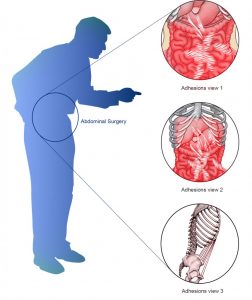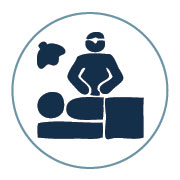Unlock the potential for pain-free movement and improved quality of life with Clear Passage Physical Therapy’s Free Consult and Request Info – discover how their unique, non-surgical manual therapy approach can effectively treat fascial adhesions, addressing chronic pain, infertility, and various other symptoms without the risks of additional scar tissue formation. To learn more visit our Apply to Therapy page.
What is Fascia?

Fascia, pronounced fah-sha is an incredibly important but often misunderstood type of tissue in the body. Fascia is the most abundant connective tissue inside the body. A thin casing of connective tissue, fascia, wraps around and holds everything inside your body together, including muscles, organs, nerves, blood vessels, etc. On top of connecting every part of your body together, the fascia also has its own nerves that can make it as sensitive as skin which is why it plays such a vital role in chronic pain conditions.
Although to the blind eye, fascia may look like a single piece of tissue, it is composed of several layers with fluid in between them called hyaluronan. The goal of this fluid is to allow frictionless movement between different structures of the body while you move, aiming to prevent injury.
How do Adhesions Affect Fascia?

Now that you are familiar with how fascia works, we’re going to talk about how adhesions or inflammation can reduce the effectiveness of fascia, creating mechanical dysfunction within the body.
As stated above, fascia is supposed to create a frictionless surface to allow structures, like joints, to move freely without pain. Inflammation can damage the surface of the fascia; subsequently, scar tissue is formed in order to repair the damaged tissue. The scar tissue, also known as adhesions, can sometimes cause abnormal attachments between body tissues, preventing the structures from functioning properly and eventually causing pain.
What are adhesions?
Adhesions, more commonly known as scar tissue, are tiny strands of collagen that form during the healing process. They can form after any kind of trauma or injury such as inflammation, surgery, radiation therapy, or infection. You may have even formed adhesions when you fell off your bike as a child. Since everyone has developed adhesions throughout their life without even noticing, they usually don’t cause any issues. However, many people suffer from conditions caused by adhesions.

Fascial adhesions can restrict blood supply and damage nerves, leaving you with chronic pain and dysfunction. One of the most common conditions caused by fascial adhesions is carpal tunnel syndrome. Caused by repetitive strain, nerve pain develops in many people who spend long periods at the computer.
Once adhesions are formed they are extremely difficult to get rid of. Adhesions restrict movement and cause damage to the surrounding area, triggering more inflammation. The increase in inflammation tells the body to send in more collagen links, resulting in even more adhesion development. Over time as movement of the area becomes more restricted, the adhesions harden and solidify. This can be easily witnessed in conditions like a frozen shoulder where the shoulder is literally stuck in place due to scar tissue and adhesions restricting its mobility.
Now picture a more sensitive structure inside the body like the bowel or fallopian tube. If adhesions can restrict movement of the shoulder, they can easily cause a blockage in the bowel or a fallopian tube. Similar to the shoulder, adhesions (most commonly formed after an abdominal surgery or some type of pelvic infection like PID) will wrap around delicate organs and block the flow of material.
Common symptoms that mean you have adhesions
You are probably wondering if you have adhesions. Most likely, yes. If you have had a surgery, infection, sports injury or some other form of physical trauma you have adhesions. This becomes an issue when you start noticing chronic issues somewhere in the body. Adhesion related disorders can manifest as chronic pain, infertility or digestive problems.
Here are the main symptoms you should watch out for to establish if you have adhesions:
- Chronic pain
- Infertility
- Bowel obstruction
- Urinary bladder dysfunction
- Pain or difficulty having a bowel movement
- TMJ pain
- Pain while moving
- Mobility/flexibility issues
- Chronic headaches
- Pain during intercourse
Did you answer yes to one or more of these symptoms? Do you also have a history of surgery, infection or physical trauma? There is a very good chance your condition is being caused by fascial adhesions.
How do you treat fascial adhesions?
So you answered yes to the questions above. Now what? As I explained earlier the body has no way to remove adhesions on its own. Once the adhesions have solidified and become attached to your fascia they are stuck there until you seek some form of treatment. What are your treatment options?

Foam rolling – Depending on the severity of your condition you can attempt foam rolling. The basic idea behind foam rolling is applying pressure with a moderately hard surface to the area you have fascial adhesions. Although you can’t completely get rid of the adhesions you can loosen and detach them to return mobility and decrease pain in the area.

Stretching routine – Since adhesions reduce the mobility and function of a muscle or the fascia in a surrounding area, stretching can be incredibly beneficial to relieve pain and restore mechanical function to the site of fascial adhesions. Similar to foam rolling, when you stretch consistently, the adhesions become loosened, and you will slowly regain an increased range of motion. Think of it as stretching an elastic waist band further and further each day, eventually the elasticity will be reduced to almost nothing.

Medication –Sometimes medical intervention is necessary to relieve fascial adhesion symptoms. Many people experience chronic pain in association with fascial adhesions so some form of pain medication or anti-inflammatory may be needed in conjunction with the above treatment methods. However, please note that medication only treats the symptoms of your fascial adhesions—not the root problem.

Lysis of adhesions – This is the surgical process of cutting adhesions to allow the mechanical function of the fascia or affected organs to be restored. Since surgery is the most common cause of adhesions, this method only provides temporary relief and isn’t a permanent solution. It can also cause more adhesions to form as the body uses internal scar tissue to repair itself from surgery.

Manual therapy – Manual therapy is an approach in which a highly trained physical therapist uses a specific treatment protocol to detach and loosen adhesions with their hands. This treatment is incredibly effective at treating conditions that are too advanced for a patient to do themselves or as a replacement for surgical intervention. Since manual therapy is a non-surgical treatment, there isn’t the risk of additional adhesion formation as seen in the surgical intervention of conditions like infertility, bowel obstruction or chronic pain. With more than 25 years of experience treating adhesive disorders, we have found this to be the most effective treatment.
Related Content:
- Adhesions and Scar Tissue
- Abdominal / Pelvic Adhesions
- Fascia and Fascial Adhesions
- What You Need to Know About Pelvic Adhesions
- Do Abdominal Adhesions Show on an MRI Scan?
- Patient Story: No Longer Shackled by Adhesions
- 3 Ways Adhesions Cause Bowel Obstructions
- How to Prevent Surgery Adhesions
- Adhesions in the Body: Presentation by Larry Wurn (Video)
- Break the Adhesion-Surgery Cycle
- Lifesaving Therapy for Intestinal Obstructions Comes to St. Louis
- Pelvic Adhesions: What You May Not Know
- What Are Adhesions? (Infographic)
- Adhesions: What You Can’t See Can Hurt You
- How Can Therapy Help Adhesions



